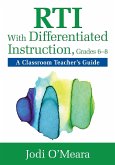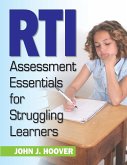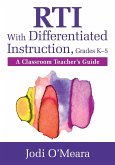- Broschiertes Buch
- Merkliste
- Auf die Merkliste
- Bewerten Bewerten
- Teilen
- Produkt teilen
- Produkterinnerung
- Produkterinnerung
Practical solutions for implementing RTI and improving student outcomes in Grades 6-12! This comprehensive book provides the specific guidance secondary administrators need to successfully implement Response to Intervention (RTI) and help their struggling adolescent learners. Using the latest research, the authors identify the current best practices for key components of RTI and demonstrate how teams can work together to implement an assessment- and data-driven decision-making process. The book provides: Guidance on building leadership capacity for RTI implementation Case studies illustrating…mehr
Andere Kunden interessierten sich auch für
![Advanced Strategies and Models for Integrating RTI in Secondary Schools Advanced Strategies and Models for Integrating RTI in Secondary Schools]() Advanced Strategies and Models for Integrating RTI in Secondary Schools131,99 €
Advanced Strategies and Models for Integrating RTI in Secondary Schools131,99 €![RTI With Differentiated Instruction, Grades 6-8 RTI With Differentiated Instruction, Grades 6-8]() Jodi O'MearaRTI With Differentiated Instruction, Grades 6-836,99 €
Jodi O'MearaRTI With Differentiated Instruction, Grades 6-836,99 €![RTI Assessment Essentials for Struggling Learners RTI Assessment Essentials for Struggling Learners]() John J. HooverRTI Assessment Essentials for Struggling Learners37,99 €
John J. HooverRTI Assessment Essentials for Struggling Learners37,99 €![RTI With Differentiated Instruction, Grades K-5 RTI With Differentiated Instruction, Grades K-5]() Jodi O'MearaRTI With Differentiated Instruction, Grades K-536,99 €
Jodi O'MearaRTI With Differentiated Instruction, Grades K-536,99 €![Leading Effective Secondary School Reform Leading Effective Secondary School Reform]() Mikie LoughridgeLeading Effective Secondary School Reform31,99 €
Mikie LoughridgeLeading Effective Secondary School Reform31,99 €![Prose Literature For Secondary Schools Prose Literature For Secondary Schools]() Margaret AshmunProse Literature For Secondary Schools29,99 €
Margaret AshmunProse Literature For Secondary Schools29,99 €![Community Secondary Schools in Tanzania Community Secondary Schools in Tanzania]() Elia Shabani MligoCommunity Secondary Schools in Tanzania16,99 €
Elia Shabani MligoCommunity Secondary Schools in Tanzania16,99 €-
-
-
Practical solutions for implementing RTI and improving student outcomes in Grades 6-12! This comprehensive book provides the specific guidance secondary administrators need to successfully implement Response to Intervention (RTI) and help their struggling adolescent learners. Using the latest research, the authors identify the current best practices for key components of RTI and demonstrate how teams can work together to implement an assessment- and data-driven decision-making process. The book provides: Guidance on building leadership capacity for RTI implementation Case studies illustrating middle and high school RTI models Instructional strategies for tiers one, two, and three Forms, checklists, and Web and print resources
Produktdetails
- Produktdetails
- Verlag: Corwin
- Seitenzahl: 168
- Erscheinungstermin: 1. Oktober 2009
- Englisch
- Abmessung: 254mm x 178mm x 9mm
- Gewicht: 329g
- ISBN-13: 9781412971003
- ISBN-10: 1412971004
- Artikelnr.: 27180160
- Herstellerkennzeichnung
- Libri GmbH
- Europaallee 1
- 36244 Bad Hersfeld
- gpsr@libri.de
- Verlag: Corwin
- Seitenzahl: 168
- Erscheinungstermin: 1. Oktober 2009
- Englisch
- Abmessung: 254mm x 178mm x 9mm
- Gewicht: 329g
- ISBN-13: 9781412971003
- ISBN-10: 1412971004
- Artikelnr.: 27180160
- Herstellerkennzeichnung
- Libri GmbH
- Europaallee 1
- 36244 Bad Hersfeld
- gpsr@libri.de
Evelyn S. Johnson is an associate professor of special education at Boise State University and the coauthor of RTI: A Practitioner's Guide to Implementing Response to Intervention. She began her career in Washington in 1994 as a special education teacher, and then at the University of Washington, Seattle, where her research focused on the inclusion of students with disabilities in accountability systems. Johnson's work on assessment for students with disabilities has included research on accommodations and alternate assessments, as well as research on screening for reading problems. Prior to joining the faculty at BSU, she worked as a research associate for the National Research Center on Learning Disabilities (NRCLD), where she developed numerous technical assistance products to assist state and local educational agencies on RTI and learning disability identification-related issues. Currently, her research focuses on RTI implementation at the secondary levels.
Foreword
Acknowledgments
About the Authors
1. What Is RTI?
Purpose of RTI at the Secondary Level
How RTI Works
How RTI Fits With Other Education Initiatives
Purpose of This Book
How This Book is Organized
Summary
2. Implementation and Continuous Improvement
Overview
What are the Desired Outcomes?
How is RTI Expected to Lead to These Outcomes?
What Must Happen If RTI is to Work as Expected?
What Data Can be Used to Inform Implementation Efforts?
How Do We Develop a System for Analyzing and Evaluating Data?
What Systems are Needed for continuous Improvement of the RTI Process?
Summary
3. Leadership Perspectives on RTI
Overview
What is My Role as Building Leader to Implement RTI?
How Do I Start the Process of Implementation?
What Will the Professional Development Needs Be?
RTI Focuses on Academics: What About Behavior?
What if We Identify too Many Kids in Need of Intervention?
What Resources Will I Need to Provide?
What If I Don¿t Get Things Right the First Time?
RTI Implementation in Practice
Summary
4. Universal Screening
Definition: What is Universal Screening?
Why is Accuracy Important?
Purpose of Screening at the Secondary Level
What Data Should Be Collected?
Implementation
Leader Tasks
Universal Screening in Practice
Summary
5. Tier 1 Instruction
Definition: What is Tier 1 Instruction?
Purpose of Tier 1 at the Secondary Level
Implementation
Tier 1 in Practice: Cheyenne Mountain Junior High School
Leader Tasks
Summary
6. Tier 2 and 3 Intervention
Definition: What is Tier 2 and Tier 3 Intervention?
Purpose of Tiers 2 and 3 at the Secondary Level
Implementation
Tier 2 in Practice: Mattawan High School
Tier 3 Implementation
Leader Tasks
Summary
7. Progress Monitoring
Definition: What is Progress Monitoring?
Purpose of Progress Monitoring at the Secondary Level
Implementation
Leader Tasks
Summary
8. Conclusion
How is RTI Expected to Lead to Improved Student Learning?
What is the Role of Leadership for Ensuring Successful RTI Implementation?
Why We are Optimistic About the Future of RTI: Two Case Stories
Summary
Appendix: RTI Implementation Checklist
Resources
References
Index
Acknowledgments
About the Authors
1. What Is RTI?
Purpose of RTI at the Secondary Level
How RTI Works
How RTI Fits With Other Education Initiatives
Purpose of This Book
How This Book is Organized
Summary
2. Implementation and Continuous Improvement
Overview
What are the Desired Outcomes?
How is RTI Expected to Lead to These Outcomes?
What Must Happen If RTI is to Work as Expected?
What Data Can be Used to Inform Implementation Efforts?
How Do We Develop a System for Analyzing and Evaluating Data?
What Systems are Needed for continuous Improvement of the RTI Process?
Summary
3. Leadership Perspectives on RTI
Overview
What is My Role as Building Leader to Implement RTI?
How Do I Start the Process of Implementation?
What Will the Professional Development Needs Be?
RTI Focuses on Academics: What About Behavior?
What if We Identify too Many Kids in Need of Intervention?
What Resources Will I Need to Provide?
What If I Don¿t Get Things Right the First Time?
RTI Implementation in Practice
Summary
4. Universal Screening
Definition: What is Universal Screening?
Why is Accuracy Important?
Purpose of Screening at the Secondary Level
What Data Should Be Collected?
Implementation
Leader Tasks
Universal Screening in Practice
Summary
5. Tier 1 Instruction
Definition: What is Tier 1 Instruction?
Purpose of Tier 1 at the Secondary Level
Implementation
Tier 1 in Practice: Cheyenne Mountain Junior High School
Leader Tasks
Summary
6. Tier 2 and 3 Intervention
Definition: What is Tier 2 and Tier 3 Intervention?
Purpose of Tiers 2 and 3 at the Secondary Level
Implementation
Tier 2 in Practice: Mattawan High School
Tier 3 Implementation
Leader Tasks
Summary
7. Progress Monitoring
Definition: What is Progress Monitoring?
Purpose of Progress Monitoring at the Secondary Level
Implementation
Leader Tasks
Summary
8. Conclusion
How is RTI Expected to Lead to Improved Student Learning?
What is the Role of Leadership for Ensuring Successful RTI Implementation?
Why We are Optimistic About the Future of RTI: Two Case Stories
Summary
Appendix: RTI Implementation Checklist
Resources
References
Index
Foreword
Acknowledgments
About the Authors
1. What Is RTI?
Purpose of RTI at the Secondary Level
How RTI Works
How RTI Fits With Other Education Initiatives
Purpose of This Book
How This Book is Organized
Summary
2. Implementation and Continuous Improvement
Overview
What are the Desired Outcomes?
How is RTI Expected to Lead to These Outcomes?
What Must Happen If RTI is to Work as Expected?
What Data Can be Used to Inform Implementation Efforts?
How Do We Develop a System for Analyzing and Evaluating Data?
What Systems are Needed for continuous Improvement of the RTI Process?
Summary
3. Leadership Perspectives on RTI
Overview
What is My Role as Building Leader to Implement RTI?
How Do I Start the Process of Implementation?
What Will the Professional Development Needs Be?
RTI Focuses on Academics: What About Behavior?
What if We Identify too Many Kids in Need of Intervention?
What Resources Will I Need to Provide?
What If I Don¿t Get Things Right the First Time?
RTI Implementation in Practice
Summary
4. Universal Screening
Definition: What is Universal Screening?
Why is Accuracy Important?
Purpose of Screening at the Secondary Level
What Data Should Be Collected?
Implementation
Leader Tasks
Universal Screening in Practice
Summary
5. Tier 1 Instruction
Definition: What is Tier 1 Instruction?
Purpose of Tier 1 at the Secondary Level
Implementation
Tier 1 in Practice: Cheyenne Mountain Junior High School
Leader Tasks
Summary
6. Tier 2 and 3 Intervention
Definition: What is Tier 2 and Tier 3 Intervention?
Purpose of Tiers 2 and 3 at the Secondary Level
Implementation
Tier 2 in Practice: Mattawan High School
Tier 3 Implementation
Leader Tasks
Summary
7. Progress Monitoring
Definition: What is Progress Monitoring?
Purpose of Progress Monitoring at the Secondary Level
Implementation
Leader Tasks
Summary
8. Conclusion
How is RTI Expected to Lead to Improved Student Learning?
What is the Role of Leadership for Ensuring Successful RTI Implementation?
Why We are Optimistic About the Future of RTI: Two Case Stories
Summary
Appendix: RTI Implementation Checklist
Resources
References
Index
Acknowledgments
About the Authors
1. What Is RTI?
Purpose of RTI at the Secondary Level
How RTI Works
How RTI Fits With Other Education Initiatives
Purpose of This Book
How This Book is Organized
Summary
2. Implementation and Continuous Improvement
Overview
What are the Desired Outcomes?
How is RTI Expected to Lead to These Outcomes?
What Must Happen If RTI is to Work as Expected?
What Data Can be Used to Inform Implementation Efforts?
How Do We Develop a System for Analyzing and Evaluating Data?
What Systems are Needed for continuous Improvement of the RTI Process?
Summary
3. Leadership Perspectives on RTI
Overview
What is My Role as Building Leader to Implement RTI?
How Do I Start the Process of Implementation?
What Will the Professional Development Needs Be?
RTI Focuses on Academics: What About Behavior?
What if We Identify too Many Kids in Need of Intervention?
What Resources Will I Need to Provide?
What If I Don¿t Get Things Right the First Time?
RTI Implementation in Practice
Summary
4. Universal Screening
Definition: What is Universal Screening?
Why is Accuracy Important?
Purpose of Screening at the Secondary Level
What Data Should Be Collected?
Implementation
Leader Tasks
Universal Screening in Practice
Summary
5. Tier 1 Instruction
Definition: What is Tier 1 Instruction?
Purpose of Tier 1 at the Secondary Level
Implementation
Tier 1 in Practice: Cheyenne Mountain Junior High School
Leader Tasks
Summary
6. Tier 2 and 3 Intervention
Definition: What is Tier 2 and Tier 3 Intervention?
Purpose of Tiers 2 and 3 at the Secondary Level
Implementation
Tier 2 in Practice: Mattawan High School
Tier 3 Implementation
Leader Tasks
Summary
7. Progress Monitoring
Definition: What is Progress Monitoring?
Purpose of Progress Monitoring at the Secondary Level
Implementation
Leader Tasks
Summary
8. Conclusion
How is RTI Expected to Lead to Improved Student Learning?
What is the Role of Leadership for Ensuring Successful RTI Implementation?
Why We are Optimistic About the Future of RTI: Two Case Stories
Summary
Appendix: RTI Implementation Checklist
Resources
References
Index









